Nestled in the heart of the Pacific Northwest, Oregon is home to some of the best lakes in the country. Why, you may ask? Each of Oregon’s shimmering bodies of water has its unique attributes. They are surrounded by diverse landscapes and are home to incredible biodiversity. Moreover, they provide endless recreational opportunities and amenities for all interests and skill levels. From the depths of Crater Lake to the crystal-clear waters of Waldo Lake and the serene beauty of Clear Lake to the recreational haven of Detroit Lake, Oregon’s lakes offer an unparalleled blend of natural splendor and recreational opportunities.
Their water quality, accessibility, and cultural significance further elevate their status. Whether you seek the thrill of watersports, the solace of hiking trails, or the rich exploration of history, Oregon’s lakes provide an immersive experience that celebrates the harmony between humans and nature.
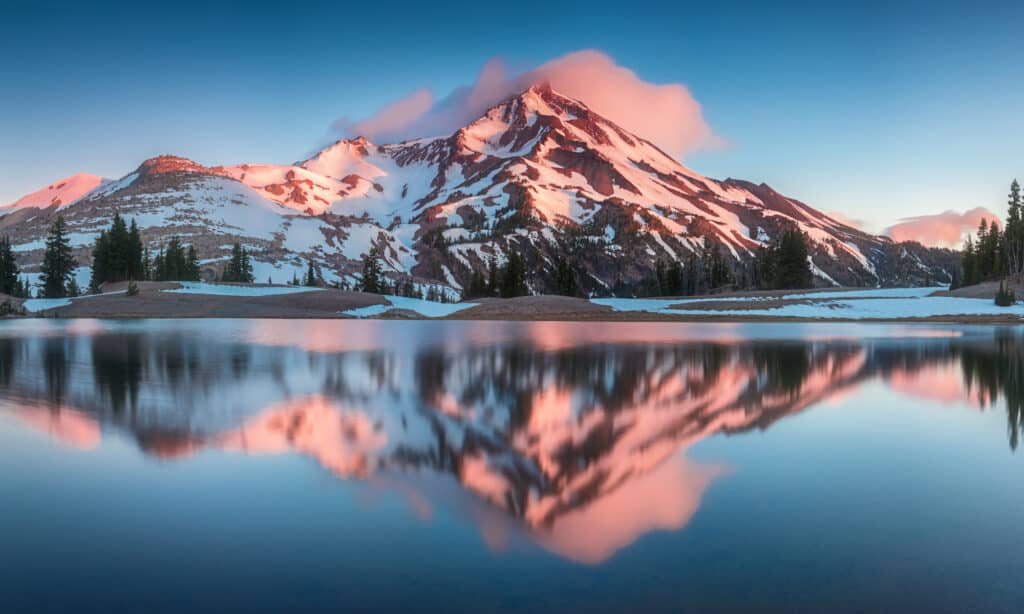
Oregon is home to over 1,400 lakes.
©Michal Balada/Shutterstock.com
1. Natural Beauty of Lakes in Oregon
Natural beauty is the first reason on our list of why Oregon has some of the best lakes in the country. Encompassing diverse landscapes that evolve and transform with the changing seasons, it is home to gorges, canyons, wetlands, mixed forests, mountains, rolling hills, deserts, and salty coastlines. All of which are dotted with lakes. As an evergreen state surrounded by lush forests, diverse landscapes, and thriving ecosystems, it’s evident why Oregon’s lakes are considered some of the finest in the nation.
During the summer, the lakes of Oregon offer a refreshing escape from the heat. They invite people in with their fresh, cool waters and allow outdoor enthusiasts to partake in a myriad of activities. They include swimming to boating, surrounded by evergreen and vistas. While in autumn, Oregon’s lakes truly reveal their transformative beauty. As the deciduous trees don their vibrant red, orange, and gold hues, the surrounding landscapes become a breathtaking spectacle. This radiant symphony of colors is mirrored in the serene surfaces of many lakes. Moreover, it creates a scene of unparalleled natural splendor.
What sets Oregon’s lakes apart, beyond their picturesque landscapes, is the state’s unwavering commitment to conservation and environmental stewardship. Strict regulations and rigorous conservation efforts ensure the continued pristine condition of its incredible lakes. Protected habitats surrounding the lakes provide sanctuary to a diverse array of wildlife, further enhancing the overall allure of these oases.
The natural beauty of Oregon’s lakes transcends the boundaries of seasons. The state’s dedication to preserving its natural lands makes Oregon’s lakes some of the best in the country.
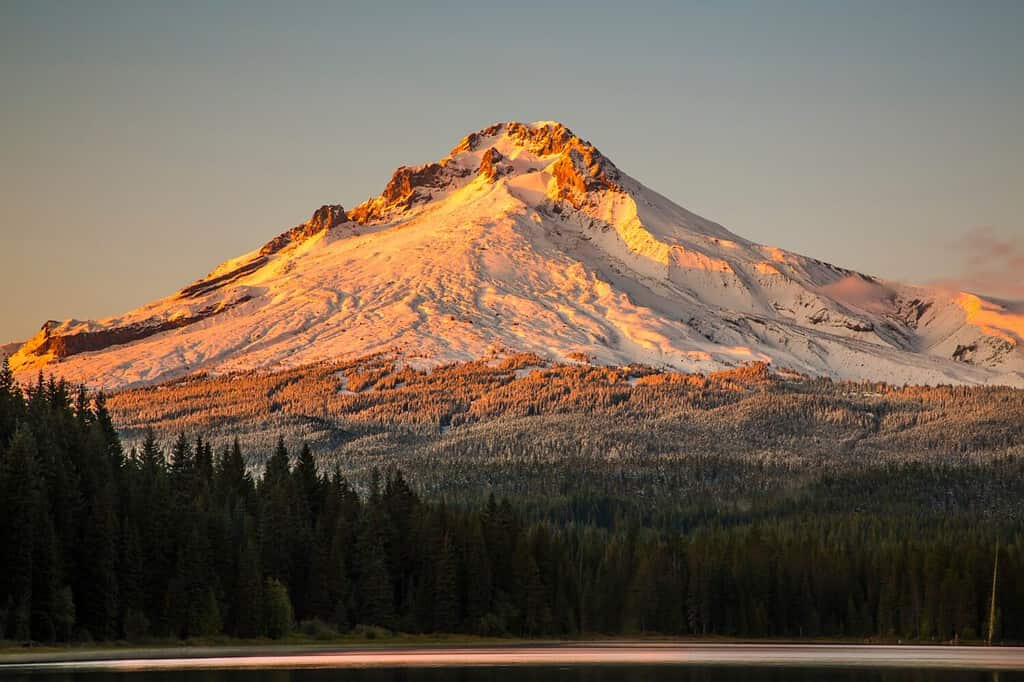
Trillium Lake is one of the most popular lakes in Oregon. It is located in the Mount Hood National Forest, approximately 7.5 miles south-southwest of Mount Hood itself.
©kwan tse/Shutterstock.com
2. Size and Diversity of Lakes in Oregon
Next, our list of reasons why Oregon has some of the best lakes in the country considers the size, diversity, and frequency of the state’s lakes. It is without question that Oregon’s claim to having some of the best lakes in the country can be attributed to the remarkable diversity, size, and unique characteristics of its lakes.
Oregon is well-known for its water. This Pacific Northwest state boasts over 1,400 named lakes, over 100,000 miles of rivers and streams, and a whopping 360 miles of coastline. Its lakes range from small, serene bodies of water to expansive, awe-inspiring expanses. One standout is Crater Lake, which holds the prestigious title of the deepest lake in the United States, plunging to a remarkable 1,943 feet (592 meters) at its deepest point. This marvel has dark, sapphire-blue waters, making it a natural wonder that captivates visitors from around the globe.
Lakes in Oregon are not concentrated solely in one region. Instead, they are scattered across the state, adding to its convenience. The state is home to many pristine mountain lakes, such as Wallowa Lake, Sparks Lake, Paulina Lake, Waldo Lake, and Diamond Lake. A few of these lakes happen to be some of the best lakes in Oregon for swimming as well. The high-altitude lakes of this region offer respite from the summer heat with their crystal-clear, cool waters and breathtaking mountain vistas.
Furthermore, Oregon’s lakes include natural and man-made lakes. Natural lakes, like Waldo Lake and Diamond Lake, are characterized by their stunning clarity and pristine waters. Man-made reservoirs, such as Fern Ridge Lake and Lake Owyhee, provide recreational opportunities while maintaining a delicate balance with the surrounding ecosystems.
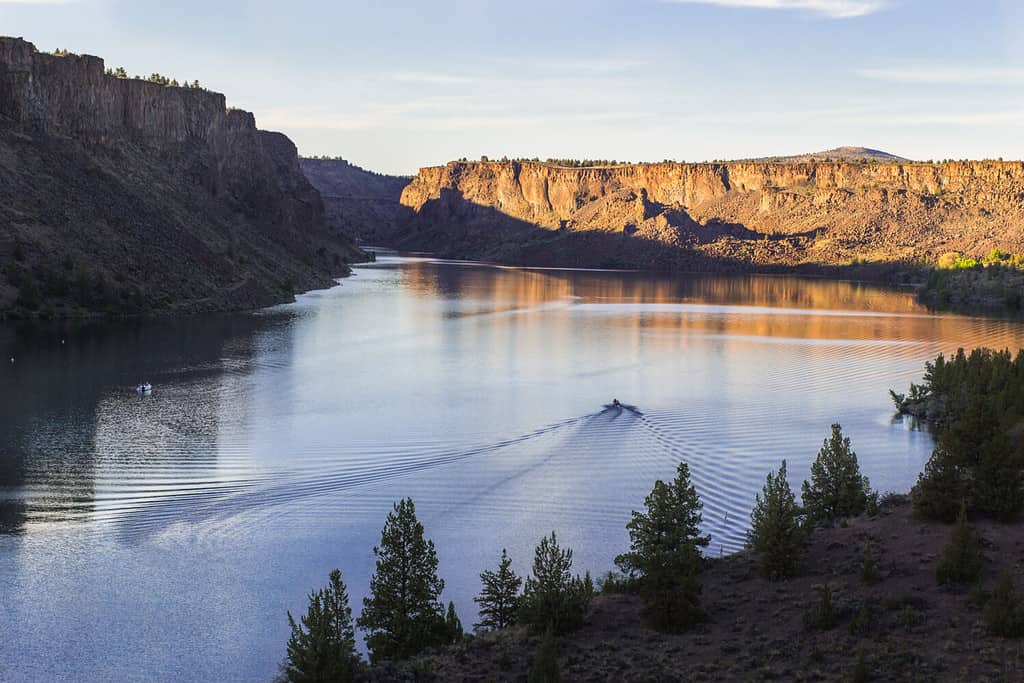
Oregon has lakes scattered across its lands. Whether north, south, east, or west, there are lakes to explore and enjoy.
©Victoria Ditkovsky/Shutterstock.com
3. Water Quality of Lakes in Oregon
Many lakes in Oregon are renowned for their exceptional water quality. This makes Oregon stand out as one of the best states for lakes in the country. Moreover, this is attributed to several unique factors.
Firstly, Oregon’s geographic location in the Pacific Northwest provides a favorable environment for facilitating great water quality. The state’s ample rainfall and the snowmelt from the Cascade Range contribute to a continuous flow of fresh, clean water into its lakes, ensuring a steady renewal of the natural water supply.
Furthermore, environmental regulations and conservation efforts play a role in preserving the quality of these lakes. Oregon’s commitment to safeguarding its natural treasures includes measures to prevent pollution, manage water usage, and protect sensitive ecosystems. State agencies like the Oregon Department of Environmental Quality actively monitor water quality to ensure it meets or exceeds established standards.
Protected natural areas surrounding the lakes also contribute to their water quality. These designated habitats serve as filters, helping to mitigate the effects of harmful run-off reaching water sources and maintaining the integrity of the ecosystems within and around the lakes.
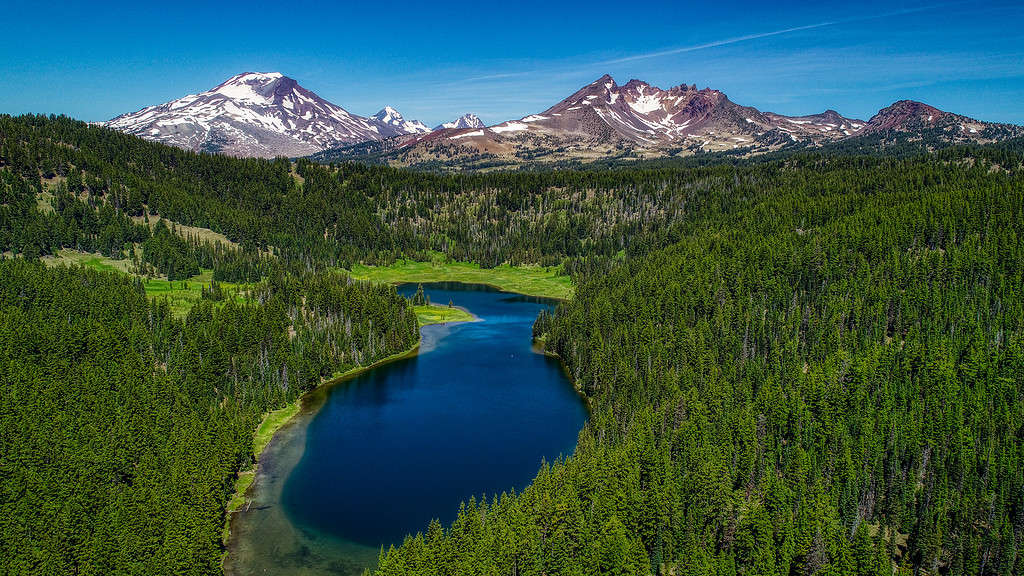
Oregon has some of the clearest lakes in the world. Many of these lakes are alpine lakes, such as Todd Lake.
©Cascade Drone Photography/Shutterstock.com
4. Biodiversity of Lakes in Oregon
Oregon’s lakes are teeming with biodiversity, making them incredibly biologically diverse aquatic ecosystems. These freshwater havens support a rich array of animals, both in the water and on land, as well as those soaring through the skies. The plant life surrounding and within Oregon’s lakes also contributes to this remarkable biodiversity. Thus, Oregon’s incredible biodiversity is another reason why it has some of the best lakes in the country.
You can find an assortment of aquatic species throughout Oregon’s lakes. Fish such as rainbow trout, cutthroat trout, and kokanee salmon thrive in the cool, oxygen-rich waters. Other species include the Pacific banana slug and Pacific tree frog, which add to the diversity, as do various aquatic invertebrates, including freshwater mussels and various species of dragonflies.
The lakes of Oregon are not only a sanctuary for aquatic life but also serve as a crucial habitat for animals on land. You may encounter mule deer, black bears, coyotes, and numerous bird species along their shores. You can often see birds of prey, like ospreys and bald eagles, soaring above the lakes, hunting for fish to sustain their populations.
Plant life in and around Oregon’s lakes contributes to the region’s ecological richness. Aquatic vegetation, such as water lilies and pondweed, provide animals with essential habitat and food sources. On the shores, you’ll find a diverse array of coniferous and deciduous trees, shrubs, and wildflowers that support terrestrial wildlife and enhance the scenic beauty of these landscapes.
The combination of aquatic species, terrestrial animals, and lush plant life creates a harmonious ecosystem that showcases the state’s incredible biodiversity.
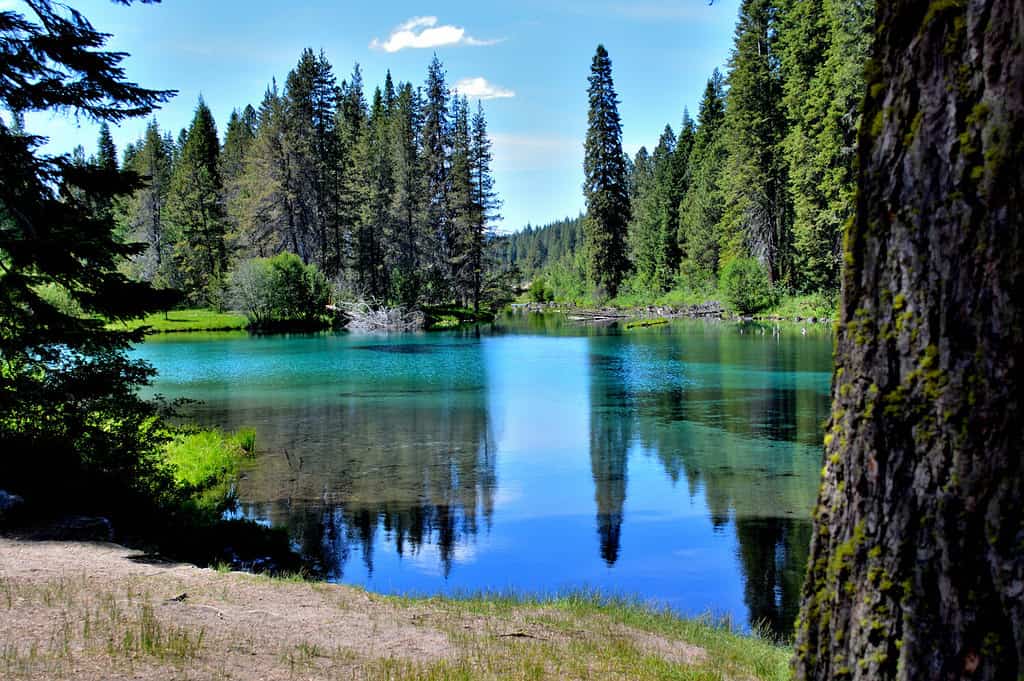
Oregon’s lakes are teeming with rich biodiversity. From numerous species across amphibians, birds, fish, mammals, reptiles, and invertebrates, many animals thrive along Oregon’s lakes. Not to mention the bountiful plant species in and around these lakes.
©David Crockett Photo/Shutterstock.com
5. Recreational Activities on and Near Lakes in Oregon
Oregon’s lakes offer a wealth of recreational opportunities. This reason makes Oregon one of the best states in the country for lakes and a haven for outdoor enthusiasts throughout the year. These pristine bodies of water provide a picturesque backdrop for a wide range of activities, both on and off the water.
In the warmer months, water-based activities abound. Kayaking and canoeing allow visitors to explore the serene expanses of any lake. In contrast, motorized boating is permitted on specific lakes and provides excitement and speed. Tubing and waterskiing offer thrilling adventures, and wakeboarding challenges those seeking an adrenaline rush. Paddleboarding allows for a more tranquil connection with the water while swimming offers a refreshing reprieve from the summer heat. For the daring, cliff jumping into Oregon’s lakes can be an exhilarating experience. Those seeking relaxation can sunbathe on the sandy shores or enjoy lakeside picnics with family and friends. Furthermore, for those who prefer a more refined pace, rowing and sailing offer a serene way to appreciate the water.
As the seasons change, Oregon’s lakes continue to draw crowds. In autumn, the lakeside scenery transforms into a vibrant tapestry of colors between the conifers, perfect for hiking and observing the changing foliage. Winter brings opportunities for snowshoeing and cross-country skiing around frozen lakeshores. Snowmobiling and ice skating become popular pastimes on the frozen surfaces of some lakes.
People can partake in camping and backpacking opportunities year-round. These activities allow people to immerse themselves in the tranquility of Oregon’s lake landscapes. Whether you seek adventure or serenity, Oregon’s lakes provide a rich tapestry of recreational options to enjoy across all seasons.
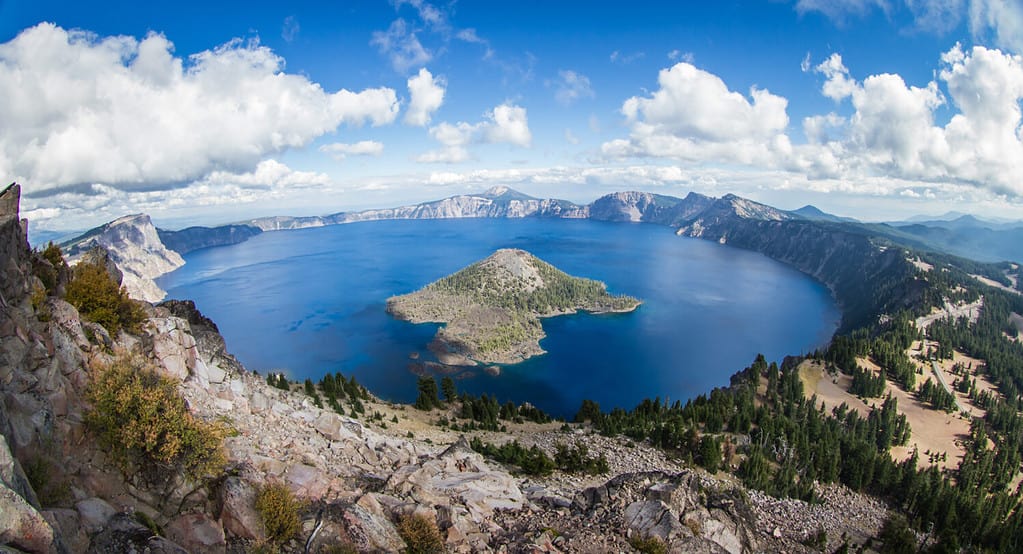
Crater Lake is one of the best-known lakes in Oregon. It is also the deepest lake in the United States, reaching depths of 1,943 feet (592 meters).
©Nature’s Charm/Shutterstock.com
6. Fishing Opportunities on Lakes in Oregon
Next on our list of reasons Oregon has some of the best lakes in the country is due to the abundant fishing opportunities. Oregon’s lakes not only have scenic beauty but also exceptional fishing. Whether you’re an angler seeking year-round fishing adventures or are looking for diverse species, Oregon is a great destination.
Oregon’s lakes provide fishing opportunities throughout the year. In the warmer months, anglers can cast their lines for species like rainbow trout, largemouth bass, and crappies. These lakes also support popular warm-water fishing activities like fly fishing and trolling.
Winter brings the opportunity for ice fishing on some lakes, creating a unique and thrilling experience. Anglers can target species of trout while enjoying the serene frozen landscapes.
Oregon’s lakes host a diverse array of fish species. There’s a fish for every preference, making it an angler’s paradise. To ensure sustainable fishing and conservation, Oregon imposes regulations and licensing requirements. Anglers must familiarize themselves with local fishing regulations to protect fish populations and their habitats.

Oregon’s lakes provide plentiful recreational opportunities for all skill levels and interests.
©B North Photography/Shutterstock.com
7. Scenic Trails and Parks Around Lakes in Oregon
Another reason Oregon has some of the best lakes in the country is that some of the best are in state parks, national parks, and other wilderness areas. Oregon’s lakes are natural wonders and gateways to a wealth of outdoor adventures. Encircled by scenic trails, embraced by state parks, and often situated in or near national parks, these lakes offer everyone an array of recreational opportunities.
Hiking enthusiasts can explore a multitude of trails that wind through lush forests, along rugged lake shorelines, and to breathtaking viewpoints. Crater Lake National Park boasts the Crater Rim Trail, offering panoramic vistas of the mesmerizing blue waters of Crater Lake. Diamond Lake, nestled near Mount Thielsen Wilderness, invites hikers to traverse picturesque paths through forests.
Camping is a cherished pastime around Oregon’s lakes. State parks such as Clear Lake and Timothy Lake offer campgrounds with easy access to the water, making them ideal for family getaways. Adventurous souls can embark on backpacking trips in areas like the Three Sisters Wilderness, with its pristine alpine lakes and challenging trails.
For those seeking a more leisurely experience, casual walks and day adventures are also plentiful. Whether you’re seeking a secluded nature experience for the day or a quick leisurely walk close to town, lakes offer ample opportunities. Overall, Oegon’s lakes are a gateway to a world of outdoor wonders, offering something for every nature enthusiast, from hikers and campers to casual walkers.

Upper Klamath Lake is a lake of great importance for the Klamath Tribe. It has provided them with abundant resources and is of spiritual significance.
©iStock.com/4nadia
8. Accessibility and Amenities Found at Lakes in Oregon
Considering convenience, Oregon’s lakes offer a diverse range of accessibility and amenities, catering to a variety of outdoor preferences and timelines. Whether you seek easy-to-access lakes with abundant amenities or remote lakes for a more secluded experience, Oregon has it all. This is another reason why Oregon has some of the best lakes in the country.
For those who prefer convenience, several lakes in Oregon provide easy accessibility and a host of amenities. Popular destinations like Cultus Lake and Elk Lake near Bend offer well-maintained campgrounds, picnic areas, and boat ramps. Visitors can enjoy the comfort of modern facilities and even rent cabins for a more comfortable experience.
However, Oregon also harbors hidden gems that require a more adventurous spirit and self-sufficiency. Remote lakes like Waldo Lake in the Willamette National Forest offer solitude and pristine natural beauty. To access other more remote lakes, such as Olallie Lake, travelers may need to hike in. Moreover, amenities may be limited to basic campgrounds. This appeals to those seeking more seclusion that difficult-to-access lakes can provide.
Oregon’s lakes cater to a broad spectrum of preferences, from easily accessible and well-appointed destinations to remote, tranquil hideaways. Whether you seek the convenience of amenities or the remoteness of wilderness, Oregon’s lakes ensure every visitor can find their own ideal lakeside experience.
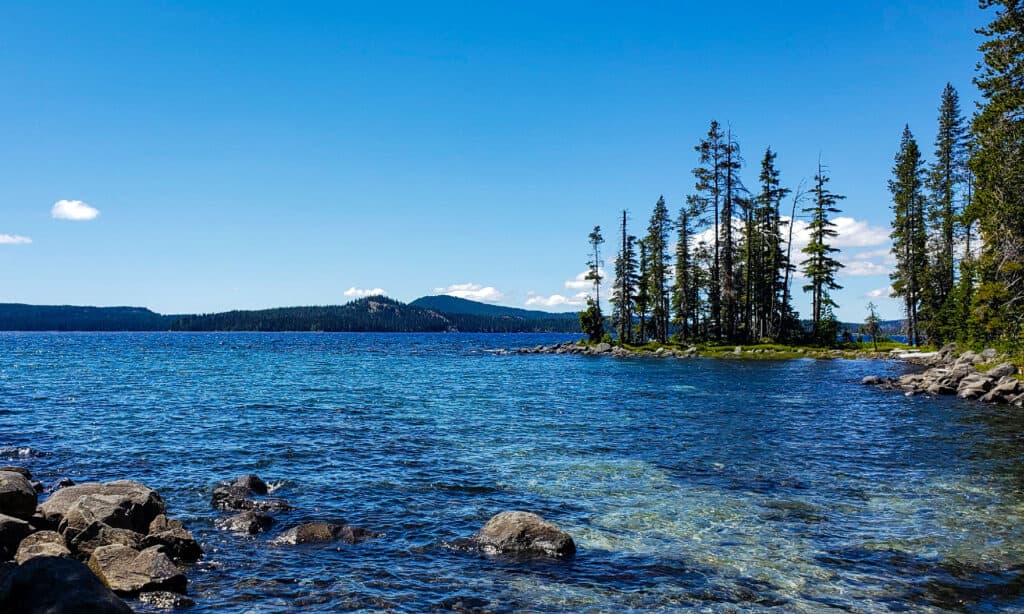
Waldo Lake is approximately 5.75 miles long and 2.75 miles wide. It is located in the Cascade Mountains.
©Amy Bradley MNR/Shutterstock.com
9. Cultural and Historical Significance of Lakes in Oregon
Oregon’s lakes bear not only natural significance but also deep cultural and historical importance. Its lakes have woven themselves into the fabric of Oregon’s heritage. Additionally, it has shaped the state’s culture and provided a window into its history.
Many of Oregon’s lakes have held and still hold sacred value for Indigenous peoples, serving as integral parts of their cultural heritage. For example, Upper Klamath Lake has long been cherished by the Klamath Tribes for its abundant resources and spiritual significance. It is a place where traditions, stories, and ceremonies have been passed down through generations. Unfortunately, settlers have displaced many tribes from their native lands, taking control of access and resources of many lakes in the process.
During the westward expansion, Oregon’s lakes played a pivotal role as sources of sustenance and transportation. The Oregon Trail, a historic pioneer route, passed near many of these lakes, providing settlers with access to fresh water and fertile lands.
In the 20th century, the development of lakeside resorts and recreational facilities transformed these natural wonders into hubs of leisure and relaxation. Crater Lake National Park was established in 1902. It became an example of Oregon’s commitment to conservation and the preservation of its natural treasures.
Today, Oregon’s lakes continue to be cultural and historical touchstones. They serve as venues for community gatherings, festivals, and events, celebrating the state’s heritage and natural beauty. As we appreciate Oregon’s lakes for their scenic grandeur, we also honor the deep cultural and historical roots that have made them an integral part of the state’s identity.
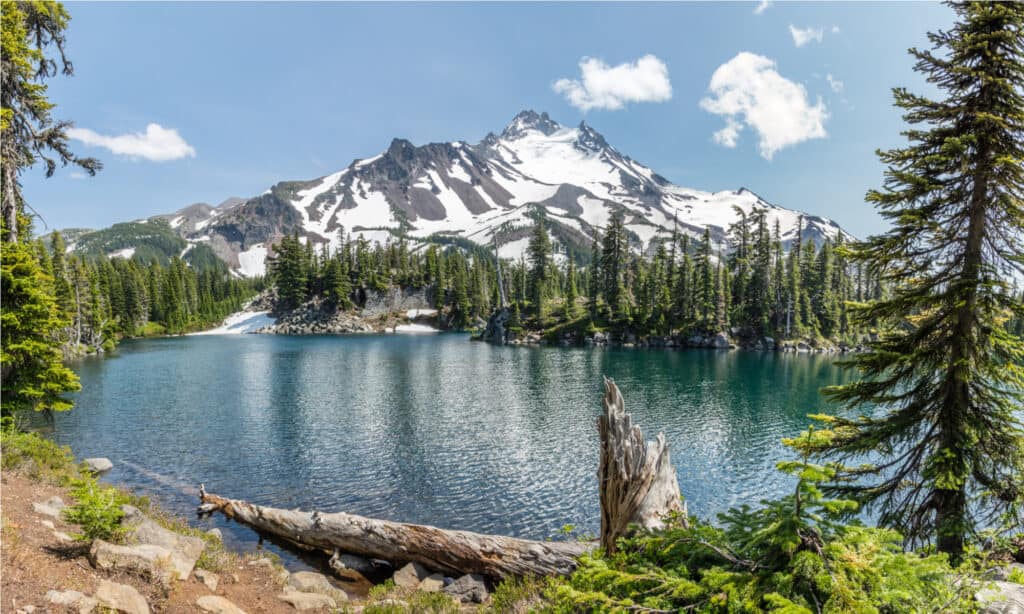
Oregon’s lakes welcome seasoned adventures and newbies alike, providing enriching experiences for all.
©Peter K. Ziminski/Shutterstock.com
Seven Stunning Lakes in Oregon
Crater Lake
Crater Lake is one of Oregon’s crown jewels, renowned for its breathtaking sapphire-blue waters. It’s the deepest lake in the United States and one of the most sought-after destinations in the Pacific Northwest. The surrounding cliffs and Wizard Island add to its dramatic beauty.
Waldo Lake
Waldo Lake has some of the clearest waters in the state. It often ranks as one of the clearest lakes in the world. Moreover, it is the second-largest natural non-alkali lake in Oregon. Waldo Lake offers a serene escape with plentiful recreational opportunities amongst the expansive wilderness. This makes it ideal for kayaking, paddleboarding, and appreciating the surrounding forests.
Clear Lake
Clear Lake lives up to its name, boasting crystal-clear waters amongst the Willamette National Forest. Fed primarily by snow run-off, it’s a popular spot for water exploration. Lush greenery surrounds the lake and offers hiking trails and boat rentals.
Timothy Lake
Nestled near Clear Lake, Timothy Lake is a peaceful gem. It offers plentiful fishing opportunities. Popular fish species include brook trout, rainbow trout, cutthroat trout, and kokanee. Moreover, It is one of the best crawdad lakes in the state. There are also plentiful camping and hiking opportunities with picturesque views reflecting on the lake’s surface.
Diamond Lake
Diamond Lake is a family-friendly destination with bountiful recreational opportunities. It’s a hub for fishing, boating, and water sports, with stunning vistas of Mount Thielsen. In winter, it transforms into a snowmobiler’s paradise.
Fern Ridge Lake
Fern Ridge Lake, or Fern Ridge Reservoir, was created by the construction of Fern Ridge Dam. It is one of the largest human-made lakes in the Willamette Valley. Its surface area spans over 9,300 acres. Moreover, it is a popular destination for power boating, sailing, hunting, and other water-based recreation. The Fern Ridge Wildlife Area, partially surrounding the lake, provides excellent opportunities for birdwatching and hiking.
Detroit Lake
Detroit Lake was formed by the Detroit Dam. It resides along the North Santiam River and offers a delightful blend of outdoor recreation and scenic beauty. Boating, fishing, and swimming are popular activities in the clear waters of this reservoir. The surrounding Cascade Range provides ample opportunities for hiking and camping.
The photo featured at the top of this post is © B North Photography/Shutterstock.com
Thank you for reading! Have some feedback for us? Contact the AZ Animals editorial team.







